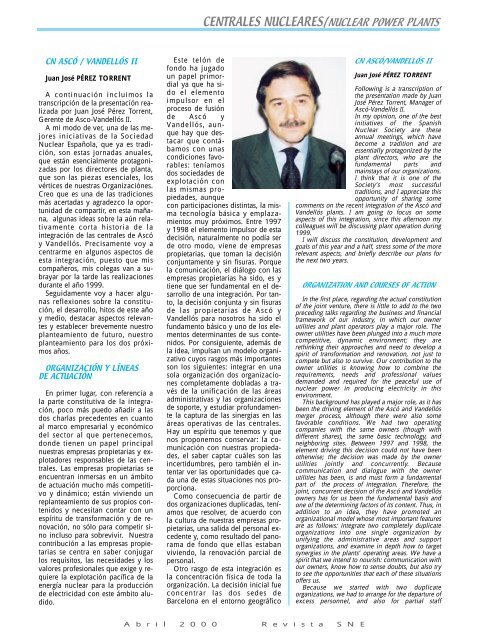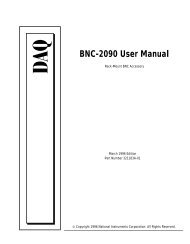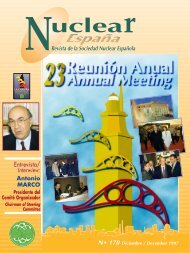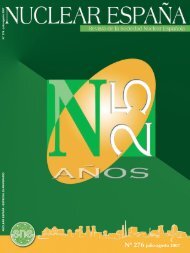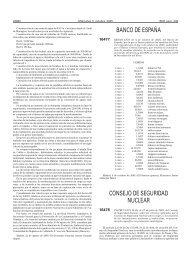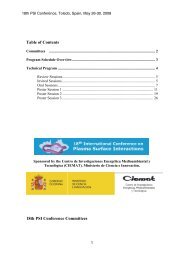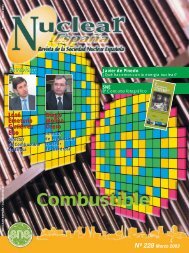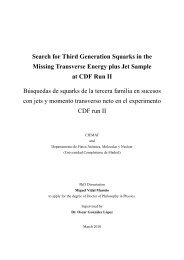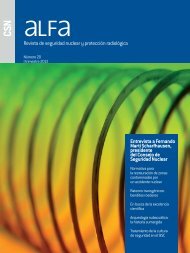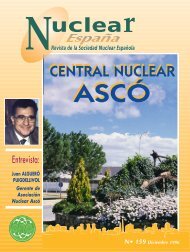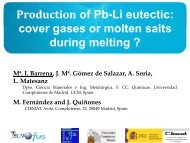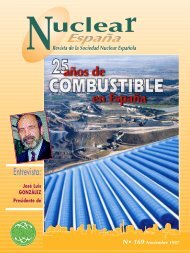EntrEntr evista/evista/ InterInter viewview
EntrEntr evista/evista/ InterInter viewview
EntrEntr evista/evista/ InterInter viewview
Create successful ePaper yourself
Turn your PDF publications into a flip-book with our unique Google optimized e-Paper software.
CENTRALES NUCLEARES/NUCLEAR POWER PLANTS<br />
CN ASCî / VANDELLîS II<br />
Juan José PÉREZ TORRENT<br />
A continuación incluimos la<br />
transcripción de la presentación realizada<br />
por Juan José Pérez Torrent,<br />
Gerente de Asco-Vandellós II.<br />
A mi modo de ver, una de las mejores<br />
iniciativas de la Sociedad<br />
Nuclear Española, que ya es tradición,<br />
son estas jornadas anuales,<br />
que están esencialmente protagonizadas<br />
por los directores de planta,<br />
que son las piezas esenciales, los<br />
vértices de nuestras Organizaciónes.<br />
Creo que es una de las tradiciones<br />
más acertadas y agradezco la oportunidad<br />
de compartir, en esta mañana,<br />
algunas ideas sobre la aún relativamente<br />
corta historia de la<br />
integración de las centrales de Ascó<br />
y Vandellós. Precisamente voy a<br />
centrarme en algunos aspectos de<br />
esta integración, puesto que mis<br />
compañeros, mis colegas van a subrayar<br />
por la tarde las realizaciones<br />
durante el año 1999.<br />
Seguidamente voy a hacer algunas<br />
reflexiones sobre la constitución,<br />
el desarrollo, hitos de este año<br />
y medio, destacar aspectos relevantes<br />
y establecer brevemente nuestro<br />
planteamiento de futuro, nuestro<br />
planteamiento para los dos próximos<br />
años.<br />
ORGANIZACIîN Y LêNEAS<br />
DE ACTUACIîN<br />
En primer lugar, con referencia a<br />
la parte constitutiva de la integración,<br />
poco más puedo añadir a las<br />
dos charlas precedentes en cuanto<br />
al marco empresarial y económico<br />
del sector al que pertenecemos,<br />
donde tienen un papel principal<br />
nuestras empresas propietarias y explotadores<br />
responsables de las centrales.<br />
Las empresas propietarias se<br />
encuentran inmersas en un ámbito<br />
de actuación mucho más competitivo<br />
y dinámico; están viviendo un<br />
replanteamiento de sus propios contenidos<br />
y necesitan contar con un<br />
espíritu de transformación y de renovación,<br />
no sólo para competir sino<br />
incluso para sobrevivir. Nuestra<br />
contribución a las empresas propietarias<br />
se centra en saber conjugar<br />
los requisitos, las necesidades y los<br />
valores profesionales que exige y requiere<br />
la explotación pacífica de la<br />
energía nuclear para la producción<br />
de electricidad con este ámbito aludido.<br />
Este telón de<br />
fondo ha jugado<br />
un papel primordial<br />
ya que ha sido<br />
el elemento<br />
impulsor en el<br />
proceso de fusión<br />
de Ascó y<br />
Vandellós, aunque<br />
hay que destacar<br />
que contábamos<br />
con unas<br />
condiciones favorables:<br />
teníamos<br />
dos sociedades de<br />
explotación con<br />
las mismas propiedades,<br />
aunque<br />
con participaciones distintas, la misma<br />
tecnología básica y emplazamientos<br />
muy próximos. Entre 1997<br />
y 1998 el elemento impulsor de esta<br />
decisión, naturalmente no podía ser<br />
de otro modo, viene de empresas<br />
propietarias, que toman la decisión<br />
conjuntamente y sin fisuras. Porque<br />
la comunicación, el diálogo con las<br />
empresas propietarias ha sido, es y<br />
tiene que ser fundamental en el desarrollo<br />
de una integración. Por tanto,<br />
la decisión conjunta y sin fisuras<br />
de las propietarias de Ascó y<br />
Vandellós para nosotros ha sido el<br />
fundamento básico y uno de los elementos<br />
determinantes de sus contenidos.<br />
Por consiguiente, además de<br />
la idea, impulsan un modelo organizativo<br />
cuyos rasgos más importantes<br />
son los siguientes: integrar en una<br />
sola organización dos organizaciones<br />
completamente dobladas a través<br />
de la unificación de las áreas<br />
administrativas y las organizaciones<br />
de soporte, y estudiar profundamente<br />
la captura de las sinergias en las<br />
áreas operativas de las centrales.<br />
Hay un espíritu que tenemos y que<br />
nos proponemos conservar: la comunicación<br />
con nuestras propiedades,<br />
el saber captar cuáles son las<br />
incertidumbres, pero también el intentar<br />
ver las oportunidades que cada<br />
una de estas situaciones nos proporciona.<br />
Como consecuencia de partir de<br />
dos organizaciones duplicadas, teníamos<br />
que resolver, de acuerdo con<br />
la cultura de nuestras empresas propietarias,<br />
una salida del personal excedente<br />
y, como resultado del panorama<br />
de fondo que ellas estaban<br />
viviendo, la renovación parcial de<br />
personal.<br />
Otro rasgo de esta integración es<br />
la concentración física de toda la<br />
organización. La decisión inicial fue<br />
concentrar las dos sedes de<br />
Barcelona en el entorno geográfico<br />
CN ASCî/VANDELLîS II<br />
Juan José PÉREZ TORRENT<br />
Following is a transcription of<br />
the presentation made by Juan<br />
José Pérez Torrent, Manager of<br />
Ascó-Vandellós II.<br />
In my opinion, one of the best<br />
initiatives of the Spanish<br />
Nuclear Society are these<br />
annual meetings, which have<br />
become a tradition and are<br />
essentially protagonized by the<br />
plant directors, who are the<br />
fundamental parts and<br />
mainstays of our organizations.<br />
I think that it is one of the<br />
Society’s most successful<br />
traditions, and I appreciate this<br />
opportunity of sharing some<br />
comments on the recent integration of the Ascó and<br />
Vandellós plants. I am going to focus on some<br />
aspects of this integration, since this afternoon my<br />
colleagues will be discussing plant operation during<br />
1999.<br />
I will discuss the constitution, development and<br />
goals of this year and a half, stress some of the more<br />
relevant aspects, and briefly describe our plans for<br />
the next two years.<br />
ORGANIZATION AND COURSES OF ACTION<br />
In the first place, regarding the actual constitution<br />
of the joint venture, there is little to add to the two<br />
preceding talks regarding the business and financial<br />
framework of our industry, in which our owner<br />
utilities and plant operators play a major role. The<br />
owner utilities have been plunged into a much more<br />
competitive, dynamic environment; they are<br />
rethinking their approaches and need to develop a<br />
spirit of transformation and renovation, not just to<br />
compete but also to survive. Our contribution to the<br />
owner utilities is knowing how to combine the<br />
requirements, needs and professional values<br />
demanded and required for the peaceful use of<br />
nuclear power in producing electricity in this<br />
environment.<br />
This background has played a major role, as it has<br />
been the driving element of the Ascó and Vandellós<br />
merger process, although there were also some<br />
favorable conditions. We had two operating<br />
companies with the same owners (though with<br />
different shares), the same basic technology, and<br />
neighboring sites. Between 1997 and 1998, the<br />
element driving this decision could not have been<br />
otherwise; the decision was made by the owner<br />
utilities jointly and concurrently. Because<br />
communication and dialogue with the owner<br />
utilities has been, is and must form a fundamental<br />
part of the process of integration. Therefore, the<br />
joint, concurrent decision of the Ascó and Vandellós<br />
owners has for us been the fundamental basis and<br />
one of the determining factors of its content. Thus, in<br />
addition to an idea, they have promoted an<br />
organizational model whose most important features<br />
are as follows: integrate two completely duplicate<br />
organizations into one single organization by<br />
unifying the administrative areas and support<br />
organizations, and examine in depth how to target<br />
synergies in the plants’ operating areas. We have a<br />
spirit that we intend to nourish: communication with<br />
our owners, know how to sense doubts, but also try<br />
to see the opportunities that each of these situations<br />
offers us.<br />
Because we started with two duplicate<br />
organizations, we had to arrange for the departure of<br />
excess personnel, and also for partial staff<br />
A b r i l 2 0 0 0<br />
R e v i s t a S N E


